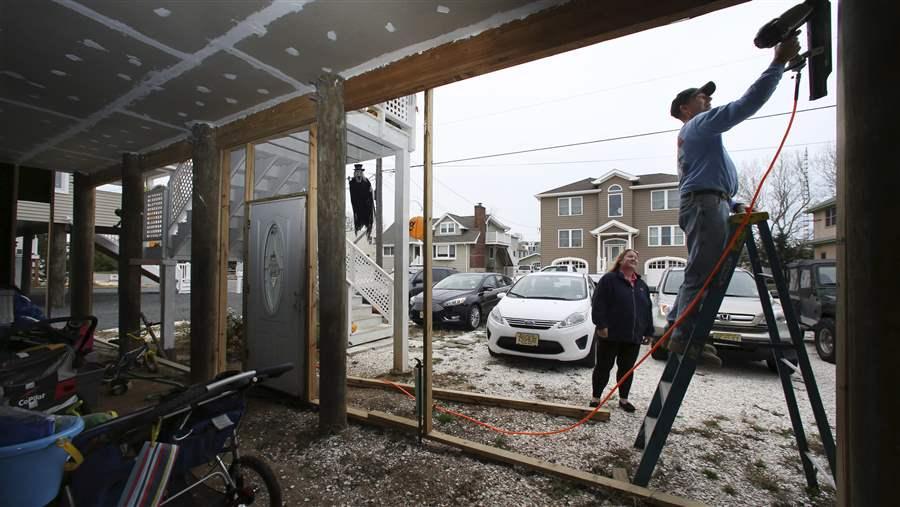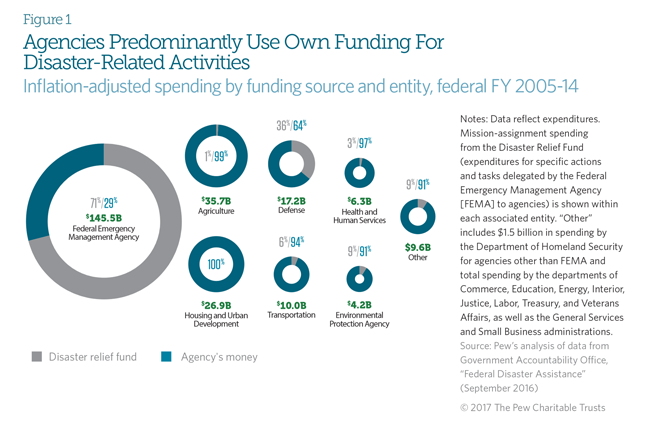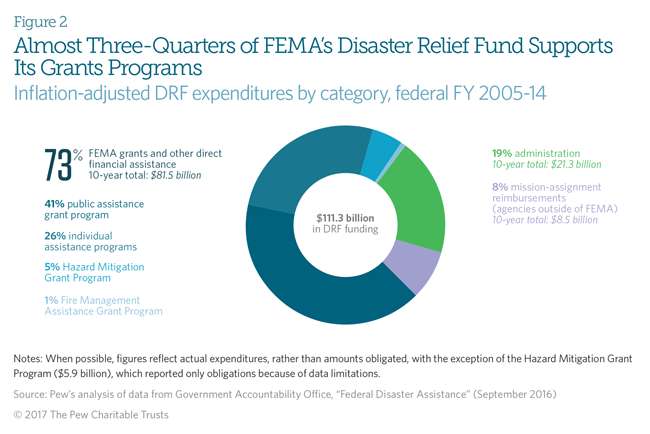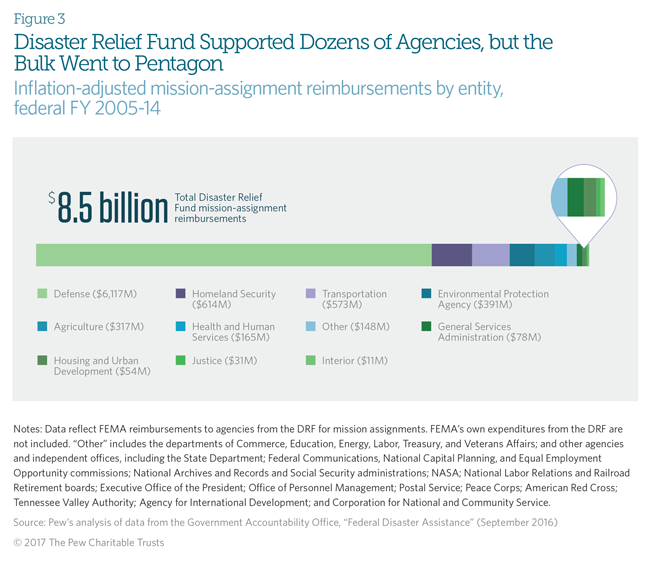Federal Disaster Assistance Goes Beyond FEMA
Hundreds of billions of dollars are spent by diverse agencies

A couple rebuilds their house in Long Beach Township, New Jersey, after Hurricane Sandy in 2012.
© Mel Evans/Associated PressDebates over federal disaster spending often focus on the Federal Emergency Management Agency’s (FEMA’s) Disaster Relief Fund, a primary funding source for disaster response and recovery. However, of the $255 billion in inflation-adjusted federal expenditures on disasters from fiscal years 2005-14, the fund accounted for only $111 billion, according to a September 2016 report by the Government Accountability Office (GAO).1 The remaining $144 billion, or 56 percent, was drawn from the budgets of 17 major federal departments and agencies.2
The Pew Charitable Trusts analyzed the Disaster Relief Fund (DRF) to better understand its role within federal disaster assistance provided to American communities. Specifically, the researchers looked at the importance of DRF funding to total disaster spending of the 17 federal entities identified by GAO as having “responsibility for leading or coordinating” disaster assistance; which programs and activities the fund supports; and how monies from the fund are distributed among agencies. The findings show that although vital, the fund is really only part of the federal government’s “all hands on deck” approach to disaster response.3
How important is the DRF to agencies’ disaster-related expenditures?
Disaster aid spending across the 17 agencies from fiscal 2005-14 ranged in real dollar terms from a low of $15 million by the Treasury Department to a high of $146 billion by FEMA, an agency in the Department of Homeland Security (DHS).4 These expenditures support dozens of programs, including the Interior Department’s Office of Wildland Fire and the Department of Housing and Urban Development’s (HUD’s) Community Development Block Grant Disaster Recovery Program. Five agencies—FEMA, Agriculture, Defense, HUD, and Transportation— accounted for 92 percent of total federal spending. However, in percentage terms, the share of disaster-related expenditures supported by the DRF varied widely, from just 0.2 percent for HUD to 71 percent for FEMA, indicating that the fund plays a significant role for specific departments and activities but is largely incidental for others. (See Figure 1.)
What programs do DRF funds support?
FEMA oversees DRF spending. The majority of these expenditures, 73 percent, were for grants and other direct financial assistance that FEMA provided to state and local governments and individuals affected by disasters from fiscal 2005-14. These included public assistance grants to state and local governments to repair and replace public infrastructure, and housing and crisis counseling aid to disaster victims through the individual assistance program. (See Figure 2.) FEMA distributed 8 percent of DRF dollars to 33 other federal departments and agencies for “mission assignments”—specific actions and tasks delegated by FEMA to provide assistance after a presidentially declared disaster.5 For example, mission assignments in 2012 directed various federal agencies to conduct debris removal and restoration of communication services, and to provide medical care for communities affected by Hurricane Sandy.6
How is DRF funding distributed?
From fiscal 2005-14, the Department of Defense received the most DRF mission-assignment funding—more than $6.1 billion, primarily for the Army and the Army Corps of Engineers; DHS was a distant second at $614 million for agencies including the Coast Guard. The third-largest total, $573 million, went to the Transportation Department to cover such costs as those for the Federal Aviation Administration. The remaining funds were spread among 30 agencies. (See Figure 3.)
Endnotes
- Government Accountability Office, “Federal Disaster Assistance” (September 2016), http://www.gao.gov/products/GAO-16-797. “Spending” refers to actual expenditures for disaster assistance programs and activities, unless noted otherwise. Total spending includes funds made available through annual and supplemental appropriations for natural, man-made, and public health-related incidents. Expenditures on “Nondeclaration Activity,” the World Trade Center Captive Insurance Co. Inc., and loans are excluded. The GAO determined that the federal government committed (or obligated) at least $277.6 billion in nominal dollars from fiscal 2005-14; the $255 billion used in this analysis is calculated from the office’s disaggregated expenditure data and adjusted for inflation.
- The GAO report showed that 33 agencies received funding from the DRF from fiscal 2005-14, but the report focused on the 17 departments and agencies that had significant expenditures for disasters from their own funds and from the DRF.
- The Pew Charitable Trusts, “When Disaster Strikes, Governments Put All Hands on Deck” (April 2017), http://www.pewtrusts.org/en/research-and-analysis/analysis/2017/04/17/when-disaster-strikes-governments-put-all-hands-on-deck.
- Total spending by agencies includes expenditures for programs and activities from their own funding and reimbursements from FEMA for mission assignments. FEMA’s total spending excludes such reimbursements to departments and agencies.
- See Endnote 2.
- Federal Emergency Management Agency, “Hurricane Sandy FEMA After-Action Report” (July 2013), https://www.fema.gov/media-library-data/20130726-1923-25045-7442/sandy_fema_aar.pdf.


In Natural Disasters, States Lend Each Other a Hand
Nationwide mutual assistance compact promises aid from neighbors


When Disaster Strikes, Governments Put All Hands on Deck
Diverse needs necessitate a coordinated federal and state approach


The Financial Toll of Flooding—Part 1
Episode 8










